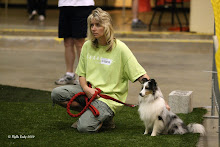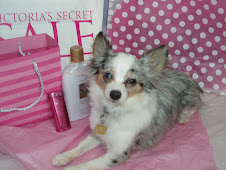I hope she doesnt mind me posting this here. I thought it was great advice and I know some people dont belong to the Clean Run yahoo site. So here it is.
>We were primarily discussing what P- really is and whether taking a>dog off the startline is P- or not.
OK, this seems to be where people need the most help.On a personal level, I find "taking a dog off the start-line" too long aprocess to really be linked to any particular behaviour. Which part is theP? Picking the dog up? Dragging it by it's collar? How does the dog linkyour actions with movement, which is otherwise heavily rewarded in agility?Lets face it if you don't go for the high-drive herding dogs - which iswhere most advice of this nature comes from - if you have to work formotivation, then you spend a lot of time rewarding motion, encouraging adesire to move. Why you'd want to punish it (reduce it) in an agilityenvironment escapes me. It's really only handlers who can take their dog's"want" or "drive" to do agility for granted that can get away with thatsort of behaviour.If you use a NRM (non reward marker) you're really saying that there is noreward available for that behaviour and in the usual form that is just asignal to try something different. What would make sense in this case is touse a conditioned punisher. You often hear people using them "no", "excuseme", "I don't think so". If your timing's good, you should be able to linkthe punishment that will follow with the action. But again, this is movingback in time to the days before we knew how to properly build behaviourwith reward. Punishment has a lot of fallout and if you use it on a regularbasis you'll find that a lot of behaviour reduces, not just your targetbehaviour. The dogs that are trained successfully this way are the oneswho's drive to do over-rides any fall-out from the punishment, for the restit's disastrous.So what to do?My first advice is for the people who have yet to step foot in the ring.Take your start-line stay and generalise it. I know shows in the USA aren'tas big as they are here, but the principle still applies. The dog that canstay at the start-line at his nice small class, in a familiar environmentwith people he knows and dogs he knows is in all probability going to haveproblems when he arrives at a 12 ring agility show with all the chaos thatthat entails if that's the only training you do. So take your dog out andabout. Again I know life is different there, but think a little and ifyou're going shopping, take your dog with you and see if he can hold hissit AND explode out of it in the car park. Where else could your dog go andtrain that will take him and you out of your comfort zone? Football match?Can you train somewhere you can hear the crowds cheering? Fun fair? Outsidea train station? At the beach? It's easy to make excuses, better to get outand do some training! :)Next if you have a hypy dog, do you ask everyone to be still and quiet whenyou train? Why not get your class mates to clap and cheer? Ask your dog tosit when another dog is working. Do you stand and chat at class, or use thetime to your advantage? What situations get your dog excited? USE them totrain, don't avoid them. At home ramp it up a little, ask your dog to sitwith food on his paws, a toy between his legs. Can he sit whilst a toy isthrown past him, if you put a bowl of just cooked sausages 2 ft away?(That's REALLY tough for a Lurcher BTW
).Next look to your release, test it, does your dog fully understand it? Isit clear? Do you inadvertently give it on the way out to your lead outposition (think about the people who hold a flat hand up - how close isthat to a jump signal and do you really want your dog to have to make thatkind of discrimination in the ring?)? What happens if you give your releasewith no movement and no body signals? If your release is linked to movementare you sure you don't release your dog when you lead out?Moving on to shows, if you take your green dog to a trial, you're puttinghim in a position that he's never been in before. So why ask for a 4 jumplead-out? As with anything else when you up the distraction levels, lowerthe criterion. Why not stand next to him, verbally reward and then release.If that's OK, try one step away, two steps away, 3 steps away. Build itslowly and build on success. If you reach a point where you find your dogcan't cope, make a note of the situation and go away and train for itbefore you ask for it again. In training work to extend what the dog iscapable of offering, in a trial work well inside the dog's comfort zone sothat you can build on success.If your dog is nervous or unsure, do you really need to leave him on hisown at the start line? Wouldn't it be better to let him build a littleconfidence in you and in the ring situation before you start pushing theboundaries?The difficulty with established start-line problems is that a dog has beentaken into the ring and over faced. Add in a nervous handler who is nodoubt behaving differently and you have a dog who is missing his usual cuesand is now guessing. Most dogs have a higher history of reward for movementthan they do for stationery behaviour and so it's not too surprising thattheir guess work inevitably leads to movement. Now their handler is worriedand the next time they'll either shout a little or repeat words (most ofwhich the dog hears as "blah blah blah"). Now they're beginning to set thescene for confrontation. In a short while as they enter the ring they areboth up tight and ready for the by now inevitable confrontation that willfollow. No amount of training away from the ring will alter that in anyway. Removing the dog from the ring does nothing to help either as in manycases the signal for removal also signals the end of the stress andconfrontation and is therefore rewarding for many, which is why thebehaviour increases rather than reduces.If the above sounds like you, then the first thing you both need to do isrelax and have some fun. Desensitise the cues that are at presentassociated with confrontation and make a new association with happyconfident fun. Run with your dog for a while until he's relaxed. Most dogsafter a few months or so of competition will begin to relax, most dogssettle into competition all by themselves if you don't wind them up in thea/m way. Once your dog is more relaxed, you can begin to ask for somecontrol behaviours on the way in, a down at the corner of the ring awayfrom the start line until called in, a sit until released, and then a sitwith one pace away etc. All the time watching the dog closely for signs ofstress and having someone monitor you for signs of stress. What the dogneeds is a calm confident handler with clear signals and a clear release,breath out and relax! Little by little is the key, set the dog up tosucceed, don't over face him.At the end of the day agility is supposed to be fun, if it's a battle andis detracting from your relationship with your dog, is it really worth it?I agree that the amount of control you have at the start line, willaccurately reflect the amount you have during the round, but for many dogsthat doesn't happen right from the beginning; for some the agility scene isjust too much stimulation and handlers need to set realistic aims in thatsituation. If you know your dog isn't going to wait, what's the point inasking him to? What do you think he can do? Ask him to do that instead. Inthe mean time work on self-control not imposed control. Work on your downstays whilst your class mates are working, ask for sits at the door, waitsin the car, waits for dinner bowls. Self control. Little by little is thekey and if your dog can't sit in class, don't expect him to in the ring :)Appologies to Cathy for hijacking her post and apologies to all those whohave written asking for help, I hope this goes some way to helping.Regards,Jo Sermon, Beardies, one small Lurcher & one even smaller x.http://www.agility-training.co.uk/














